蒙特卡洛方法
蒙特卡洛方法
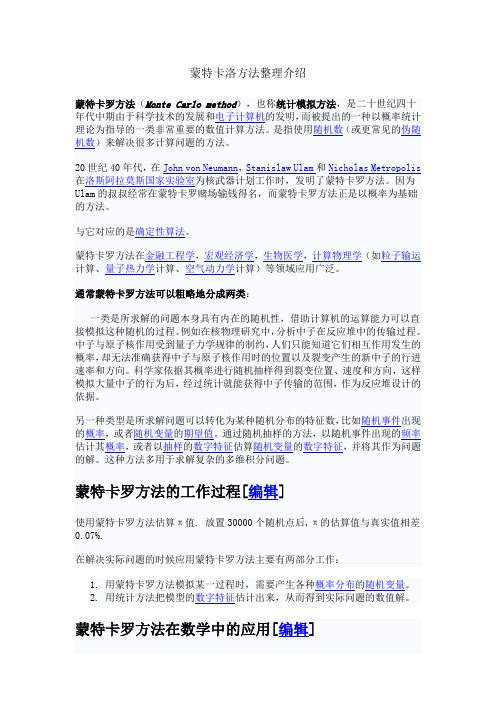
蒙特卡洛方法整理介绍
通常蒙特卡罗方法通过构造符合一定规则的随机数来解决数学上的各种问题。
对于那些由于计算过于复杂而难以得到解析解或者根本没有解析解的问题,蒙特卡罗方法是一种有效的求出数值解的方法。
一般蒙特卡罗方法在数学中最常见的应用就是蒙特卡罗积分。
积分[编辑]
非权重蒙特卡罗积分,也称确定性抽样,是对被积函数变量区间进行随机均匀抽样,然后对被抽样点的函数值求平均,从而可以得到函数积分的近似值。
此种方法的正确性是基于概率论的中心极限定理。
当抽样点数为m时,使用此种方法所
得近似解的统计误差只与m有关(与正相关),不随积分维数的改变而改变。
因此当积分维度较高时,蒙特卡罗方法相对于其他数值解法更优。
圆周率[编辑]
蒙特卡洛方法可用于近似计算圆周率:让计算机每次随机生成两个0到1之间的数,看以这两个实数为横纵坐标的点是否在单位圆内。
生成一系列随机点,统计单位圆内的点数与总点数,(圆面积和正方形面积之比为PI:4,PI为圆周率),当随机点取得越多时,其结果越接近于圆周率(然而准确度仍有争议:即使取10的9次方个随机点时,其结果也仅在前4位与圆周率吻合)。
用蒙特卡洛方法近似计算圆周率的先天不足是:第一,计算机产生的随机数是受到存储格式的限制的,是离散的,并不能产生连续的任意实数;上述做法将平面分割成一个个网格,在空间也不是连续的,由此计算出来的面积当然与圆或多或少有差距。
蒙特卡洛类方法

蒙特卡洛类方法
蒙特卡洛方法是一类随机化的计算方法,主要应用于求出高维度空间中的定积分或概率分布的特性。
该方法以随机样本为基础,通过大量生成且符合某种分布律的随机数,从中抽取样本,利用样本的统计性质来计算近似解。
常见的蒙特卡洛方法包括:
1.随机模拟法
在数学建模、广告投放、经济预测等领域,随机模拟(也称蒙特卡罗方法)已经成为了一个重要的工具。
其基本思想是,系统表现出的某些规律和性质可以用随机过程进行模拟和预测。
2.随机游走算法
随机游走是一种基于随机过程的数值计算算法,通过简单的偏随机移动来解决复杂问题,被广泛应用于物理、化学、生物学、金融等领域。
随机游走算法的核心思想是通过随机漫步遍历所有可能的状态,找到最终解。
3.马尔可夫链蒙特卡罗方法
马尔可夫链蒙特卡罗方法(MCMC)是一种近似随机模拟算法,用于计算高维空间中的积分和概率分布。
这种方法通过构造一个马尔可夫链来模拟复杂的概率
分布,并通过观察链的过程来获得所求的统计量。
4.重要性采样
重要性采样是一种通过迭代抽样来估算积分值或概率分布的方法。
它的基本思想是利用不同的概率分布来采样目标分布中的样本,从而增加目标分布中采样到重要样本的概率,从而提高采样的效率。
总之,蒙特卡洛方法在物理学、统计学、金融学、计算机科学、生物科学等众多领域都有广泛的应用,是一种很实用的工具。
蒙卡罗方法
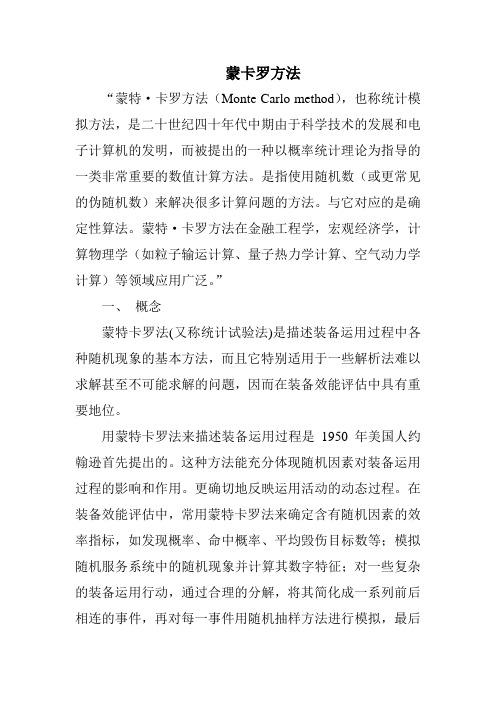
蒙卡罗方法“蒙特·卡罗方法(Monte Carlo method),也称统计模拟方法,是二十世纪四十年代中期由于科学技术的发展和电子计算机的发明,而被提出的一种以概率统计理论为指导的一类非常重要的数值计算方法。
是指使用随机数(或更常见的伪随机数)来解决很多计算问题的方法。
与它对应的是确定性算法。
蒙特·卡罗方法在金融工程学,宏观经济学,计算物理学(如粒子输运计算、量子热力学计算、空气动力学计算)等领域应用广泛。
”一、概念蒙特卡罗法(又称统计试验法)是描述装备运用过程中各种随机现象的基本方法,而且它特别适用于一些解析法难以求解甚至不可能求解的问题,因而在装备效能评估中具有重要地位。
用蒙特卡罗法来描述装备运用过程是1950年美国人约翰逊首先提出的。
这种方法能充分体现随机因素对装备运用过程的影响和作用。
更确切地反映运用活动的动态过程。
在装备效能评估中,常用蒙特卡罗法来确定含有随机因素的效率指标,如发现概率、命中概率、平均毁伤目标数等;模拟随机服务系统中的随机现象并计算其数字特征;对一些复杂的装备运用行动,通过合理的分解,将其简化成一系列前后相连的事件,再对每一事件用随机抽样方法进行模拟,最后达到模拟装备运用活动或运用过程的目的。
二、基本思路蒙特卡罗法的基本思想是:为了求解问题,首先建立一个概率模型或随机过程,使它的参数或数字特征等于问题的解:然后通过对模型或过程的观察或抽样试验来计算这些参数或数字特征,最后给出所求解的近似值。
解的精确度用估计值的标准误差来表示。
蒙特卡罗法的主要理论基础是概率统计理论,主要手段是随机抽样、统计试验。
用蒙特卡罗法求解实际问题的基本步骤为:1、根据实际问题的特点.构造简单而又便于实现的概率统计模型.使所求的解恰好是所求问题的概率分布或数学期望;2、给出模型中各种不同分布随机变量的抽样方法;3、统计处理模拟结果,给出问题解的统计估计值和精度估计值。
三、优缺点蒙特卡罗法的最大优点是:1、方法的误差与问题的维数无关。
蒙特卡洛方法
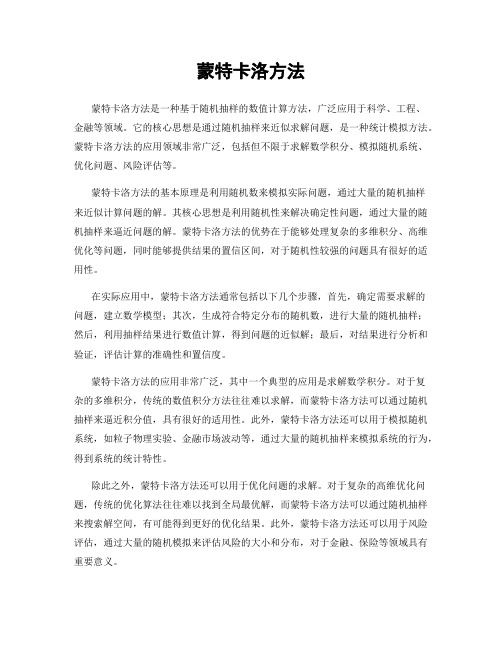
蒙特卡洛方法蒙特卡洛方法是一种基于随机抽样的数值计算方法,广泛应用于科学、工程、金融等领域。
它的核心思想是通过随机抽样来近似求解问题,是一种统计模拟方法。
蒙特卡洛方法的应用领域非常广泛,包括但不限于求解数学积分、模拟随机系统、优化问题、风险评估等。
蒙特卡洛方法的基本原理是利用随机数来模拟实际问题,通过大量的随机抽样来近似计算问题的解。
其核心思想是利用随机性来解决确定性问题,通过大量的随机抽样来逼近问题的解。
蒙特卡洛方法的优势在于能够处理复杂的多维积分、高维优化等问题,同时能够提供结果的置信区间,对于随机性较强的问题具有很好的适用性。
在实际应用中,蒙特卡洛方法通常包括以下几个步骤,首先,确定需要求解的问题,建立数学模型;其次,生成符合特定分布的随机数,进行大量的随机抽样;然后,利用抽样结果进行数值计算,得到问题的近似解;最后,对结果进行分析和验证,评估计算的准确性和置信度。
蒙特卡洛方法的应用非常广泛,其中一个典型的应用是求解数学积分。
对于复杂的多维积分,传统的数值积分方法往往难以求解,而蒙特卡洛方法可以通过随机抽样来逼近积分值,具有很好的适用性。
此外,蒙特卡洛方法还可以用于模拟随机系统,如粒子物理实验、金融市场波动等,通过大量的随机抽样来模拟系统的行为,得到系统的统计特性。
除此之外,蒙特卡洛方法还可以用于优化问题的求解。
对于复杂的高维优化问题,传统的优化算法往往难以找到全局最优解,而蒙特卡洛方法可以通过随机抽样来搜索解空间,有可能得到更好的优化结果。
此外,蒙特卡洛方法还可以用于风险评估,通过大量的随机模拟来评估风险的大小和分布,对于金融、保险等领域具有重要意义。
总的来说,蒙特卡洛方法是一种非常重要的数值计算方法,具有广泛的应用前景。
它的核心思想是利用随机抽样来近似求解问题,能够处理复杂的多维积分、高维优化等问题,同时能够提供结果的置信区间,对于随机性较强的问题具有很好的适用性。
在未来的发展中,蒙特卡洛方法将继续发挥重要作用,为科学、工程、金融等领域的问题求解提供强大的工具支持。
蒙特卡罗方法讲解
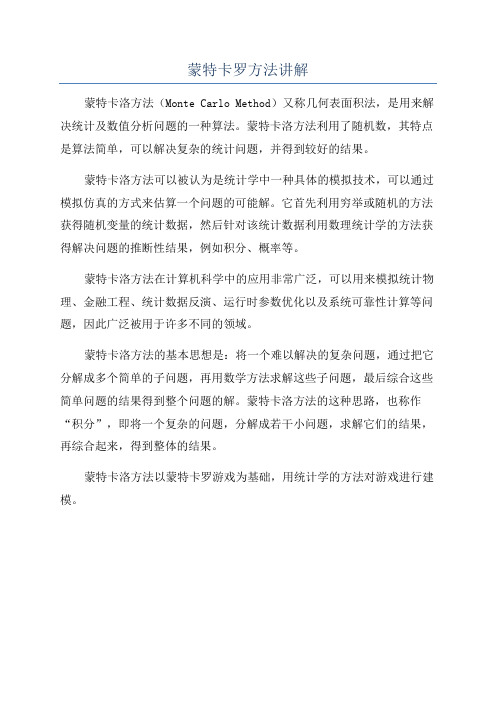
蒙特卡罗方法讲解
蒙特卡洛方法(Monte Carlo Method)又称几何表面积法,是用来解决统计及数值分析问题的一种算法。
蒙特卡洛方法利用了随机数,其特点是算法简单,可以解决复杂的统计问题,并得到较好的结果。
蒙特卡洛方法可以被认为是统计学中一种具体的模拟技术,可以通过模拟仿真的方式来估算一个问题的可能解。
它首先利用穷举或随机的方法获得随机变量的统计数据,然后针对该统计数据利用数理统计学的方法获得解决问题的推断性结果,例如积分、概率等。
蒙特卡洛方法在计算机科学中的应用非常广泛,可以用来模拟统计物理、金融工程、统计数据反演、运行时参数优化以及系统可靠性计算等问题,因此广泛被用于许多不同的领域。
蒙特卡洛方法的基本思想是:将一个难以解决的复杂问题,通过把它分解成多个简单的子问题,再用数学方法求解这些子问题,最后综合这些简单问题的结果得到整个问题的解。
蒙特卡洛方法的这种思路,也称作“积分”,即将一个复杂的问题,分解成若干小问题,求解它们的结果,再综合起来,得到整体的结果。
蒙特卡洛方法以蒙特卡罗游戏为基础,用统计学的方法对游戏进行建模。
蒙特卡洛方法
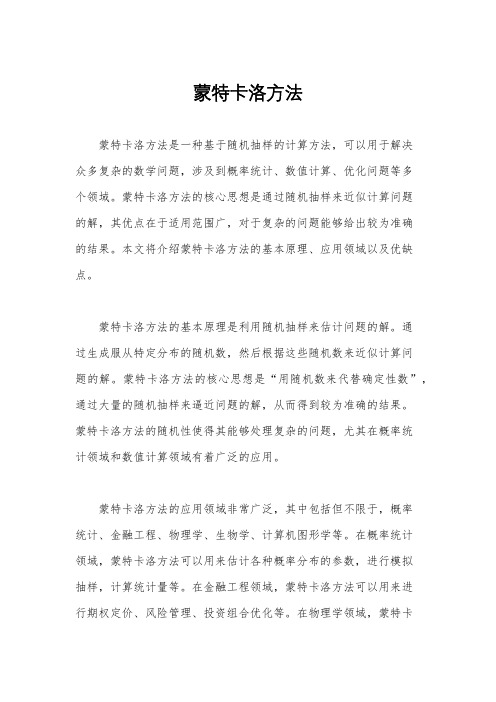
蒙特卡洛方法蒙特卡洛方法是一种基于随机抽样的计算方法,可以用于解决众多复杂的数学问题,涉及到概率统计、数值计算、优化问题等多个领域。
蒙特卡洛方法的核心思想是通过随机抽样来近似计算问题的解,其优点在于适用范围广,对于复杂的问题能够给出较为准确的结果。
本文将介绍蒙特卡洛方法的基本原理、应用领域以及优缺点。
蒙特卡洛方法的基本原理是利用随机抽样来估计问题的解。
通过生成服从特定分布的随机数,然后根据这些随机数来近似计算问题的解。
蒙特卡洛方法的核心思想是“用随机数来代替确定性数”,通过大量的随机抽样来逼近问题的解,从而得到较为准确的结果。
蒙特卡洛方法的随机性使得其能够处理复杂的问题,尤其在概率统计领域和数值计算领域有着广泛的应用。
蒙特卡洛方法的应用领域非常广泛,其中包括但不限于,概率统计、金融工程、物理学、生物学、计算机图形学等。
在概率统计领域,蒙特卡洛方法可以用来估计各种概率分布的参数,进行模拟抽样,计算统计量等。
在金融工程领域,蒙特卡洛方法可以用来进行期权定价、风险管理、投资组合优化等。
在物理学领域,蒙特卡洛方法可以用来模拟粒子的行为、计算物理系统的性质等。
在生物学领域,蒙特卡洛方法可以用来模拟生物分子的构象、预测蛋白质的结构等。
在计算机图形学领域,蒙特卡洛方法可以用来进行光线追踪、图像渲染等。
蒙特卡洛方法的优点在于适用范围广,能够处理各种复杂的问题,且能够给出较为准确的结果。
蒙特卡洛方法的缺点在于计算量大,需要进行大量的随机抽样才能得到较为准确的结果,且随机抽样的过程可能会引入误差。
因此,在实际应用中需要权衡计算成本和精度要求,选择合适的抽样方法和样本量。
总之,蒙特卡洛方法是一种重要的计算方法,具有广泛的应用价值。
通过随机抽样来近似计算问题的解,能够处理各种复杂的问题,且能够给出较为准确的结果。
在实际应用中,需要根据具体问题的特点和要求来选择合适的抽样方法和样本量,以平衡计算成本和精度要求。
希望本文能够帮助读者更好地理解蒙特卡洛方法的基本原理、应用领域以及优缺点,为实际问题的解决提供一些参考和启发。
第三章蒙特卡罗方法概述

第三章蒙特卡罗方法概述蒙特卡罗方法是一种基于概率统计的数学模拟方法,广泛应用于各个领域,如物理学、工程学、统计学、金融学等。
蒙特卡罗方法的基本思想是通过随机抽样的方法,通过大量的实验模拟系统的行为,从而推导出系统的统计性质。
它的核心理念是“试验多次,取平均值”,即通过进行大量的实验模拟,得到的结果的平均值可以近似于真实值。
蒙特卡罗方法的起源可以追溯到二战时期的原子能研究。
当时科学家们在尝试研究核反应堆的物理过程时,很难通过解析方法得到解决方案。
于是他们将问题建模成概率统计的形式,通过大量的实验模拟来获得结果。
这种方法最初被称为“纯概率模拟”,后来由于其背后的基本思想与蒙特卡罗赌场有些类似而得名为蒙特卡罗方法。
蒙特卡罗方法包括以下几个基本步骤:1.建立模型:首先需要建立一个适当的模型,即用数学方程描述所研究问题的特征。
模型的复杂程度取决于具体问题的复杂程度。
2.随机抽样:根据建立的模型,需要进行随机抽样,生成一系列符合指定分布的随机数。
这些随机数代表了系统的输入或初态。
通常使用伪随机数生成器来生成这些随机数。
3.求解模型:将随机抽样得到的样本代入模型,并通过模型进行求解。
可以使用各种数值计算方法来求解模型,如积分法、差分法、微分方程等。
通过数值计算方法,可以得到模型的输出或末态。
4.统计分析:通过大量的实验模拟,得到了系统的多组输出或末态。
在这些输出或末态中,可以统计得到系统的统计性质,如均值、方差、概率分布等。
蒙特卡罗方法的优势在于它可以处理复杂的非线性问题,以及高维问题。
由于模拟过程完全基于随机抽样,与传统的解析方法相比,蒙特卡罗方法的求解过程更加灵活。
另外,由于蒙特卡罗方法是一种直接模拟的方法,因此对于复杂的系统,可以通过蒙特卡罗方法进行近似求解,避免了复杂内部结构的精确建模过程。
然而,蒙特卡罗方法也存在一些限制。
首先,蒙特卡罗方法通常需要进行大量的实验模拟才能得到准确的结果,从而需要大量的计算时间和计算资源。
蒙特卡罗方法 分子动力学方法 有限元方法

蒙特卡罗方法、分子动力学方法和有限元方法是当前科学研究和工程技术领域中常用的数值计算方法,它们在材料科学、物理化学、工程力学等领域均有着重要的应用。
本文将从这三种方法的基本原理、应用领域和优缺点等方面进行介绍和比较。
一、蒙特卡罗方法蒙特卡罗方法是一种随机模拟的计算方法,主要用于求解概率统计问题和复杂的数学积分。
其基本原理是通过大量的随机样本来近似计算得出结果,具有较高的精度和可靠性。
蒙特卡罗方法的应用领域非常广泛,包括金融工程、通信网络、生物医学、物理模拟等方面,在材料科学领域中也有着重要的应用。
可以利用蒙特卡罗方法模拟材料的热力学性质,计算材料的热容、热传导系数等物理量。
蒙特卡罗方法的优点是能够处理复杂的非线性问题,但由于需要大量的随机样本,计算量较大,耗时较长,且结果受随机性影响较大。
二、分子动力学方法分子动力学方法是一种模拟分子运动的数值计算方法,通过求解牛顿运动方程来模拟分子在空间中的运动轨迹。
分子动力学方法在纳米材料、生物化学、材料加工等领域有着广泛的应用。
可以利用分子动力学方法模拟材料的力学性能、热学性质、表面反应等。
分子动力学方法的优点是能够考虑到分子间相互作用力的影响,较为真实地反映了材料的微观结构和宏观性能,但由于需要求解大量分子的运动轨迹,计算量也较大,且对计算机的性能要求较高。
三、有限元方法有限元方法是一种常用的工程数值计算方法,主要用于求解复杂结构的力学问题和传热问题。
其基本思想是将求解区域划分为有限个小单元,通过建立单元之间的联系,得出整个求解区域的数值解。
有限元方法在工程结构分析、材料成型、热处理过程中有着广泛的应用。
可以利用有限元方法模拟材料的应力分布、变形状态、热应力分析等。
有限元方法的优点是能够较为准确地描述复杂结构的力学和热学行为,计算精度较高,但需要进行网格划分和建立单元之间的关系,工作量较大,且求解非线性和大变形问题时较为困难。
蒙特卡罗方法、分子动力学方法和有限元方法分别在概率统计、分子模拟和结构力学领域有着重要的应用价值,对于不同的研究和工程问题可以选择合适的数值计算方法。
《蒙特卡罗方法》课件

REPORTING
优点
高效性
蒙特卡罗方法在处理大规模、复杂问 题时,相对于解析方法,具有更高的 计算效率。
适用性强
该方法适用于各种类型的问题,无论 是数学、物理还是工程领域。
灵活性高
蒙特卡罗方法允许使用各种随机抽样 技术,可以根据问题的特性灵活调整 。
易于实现
蒙特卡罗方法的算法相对简单,容易 编程实现。
估计精度
统计估计的精度与样本数量和估计方法的选 择有关。
误差分析
误差来源
蒙特卡罗方法的误差主要来源于概率模型的近似和随机抽样的不 确定性。
误差控制
通过增加样本数量、改进概率模型等方法来减小误差。
误差评估
通过方差、置信区间等统计方法对误差进行评估和检验。
PART 03
蒙特卡罗方法的实现步骤
REPORTING
《蒙特卡罗方法》 PPT课件
REPORTING
• 蒙特卡罗方法简介 • 蒙特卡罗方法的原理 • 蒙特卡罗方法的实现步骤 • 蒙特卡罗方法的应用实例 • 蒙特卡罗方法的优缺点 • 蒙特卡罗方法的未来发展与展望
目录
PART 01
蒙特卡罗方法简介
REPORTING
定义与特点
定义
蒙特卡罗方法是一种基于概率统计的 数值计算方法,通过随机抽样和统计 模拟来求解数学、物理、工程等领域 的问题。
代。
PART 04
蒙特卡罗方法的应用实例
REPORTING
金融衍生品定价
总结词
蒙特卡罗方法在金融衍生品定价中应用广泛 ,通过模拟标的资产价格变化,计算衍生品 价格和风险。
详细描述
蒙特卡罗方法通过随机抽样和概率统计,模 拟标的资产(如股票、外汇或商品等)的价 格变化,从而计算出衍生品(如期权、期货 或掉期等)的预期收益或风险。这种方法能 够处理复杂的衍生品定价问题,并给出较为 精确的估计。
蒙特卡罗方法蒙特卡罗方法解粒子输运问题

蒙特卡罗方法在粒子输运问题中价值体现
高效性
蒙特卡罗方法通过随机抽样模拟粒子输运过程,避免了复杂数学 模型的求解,大大提高了计算效率。
灵活性
该方法适用于各种复杂几何形状和边界条件,能够处理实际工程中 的复杂粒子输运问题。
精确性
通过大量的随机抽样,蒙特卡罗方法能够得到高精度的数值解,满 足工程实际需求。
发展历程
蒙特卡罗方法起源于20世纪40年代,最初用于解决原子弹设 计中的中子输运问题。随着计算机技术的发展,蒙特卡罗方 法的应用范围不断扩大,成为科学研究和工程领域的重要工 具。
基本原理及特点
基本原理
蒙特卡罗方法的基本原理是大数定律和中心极限定理。通过大量随机抽样,可 以得到随机变量的统计特征,从而近似求解实际问题。
03
蒙特卡罗方法解粒子输运 问题流程
问题定义与建模
明确粒子输运问题的物理背景和数学描述,如粒 子的类型、数量、初始状态、相互作用等。
建立粒子输运问题的概率模型,将物理问题转化 为数学问题,如概率密度函数、期望、方差等。
确定模型的输入和输出,以及需要求解的目标函 数或性能指标。
随机数生成技术
选择合适的随机数生成器,如伪 随机数生成器或真随机数生成器, 以满足模拟的精度和效率要求。
未来发展趋势预测和挑战分析
并行化技术
随着计算机技术的发展,并行化技术将进一步提高蒙特卡罗方法的计算效率。
智能化算法
结合人工智能等先进技术,实现自适应抽样和智能优化,提高计算精度和效率。
未来发展趋势预测和挑战分析
• 多物理场耦合:将蒙特卡罗方法应用于多物理场耦合问题, 实现更复杂的粒子输运模拟。
未来发展趋势预测和挑战分析
确定随机数生成器的种子和参数, 以保证模拟的可重复性和一致性。
irt 蒙特卡罗 方法

irt 蒙特卡罗方法
蒙特卡罗方法(Monte Carlo methods)是一种基于随机数和概
率统计的计算方法,用于解决无法用解析方法求解的复杂问题。
蒙特卡罗方法的核心思想是通过随机抽样和统计分析来估计问题的解。
它通常在计算机模拟中应用广泛,用于模拟随机事件和进行概率分析。
蒙特卡罗方法的基本步骤如下:
1. 定义问题:明确问题的目标和需要估计的量。
2. 构建模型:建立一个能够生成随机数的数学模型,该模型能够模拟问题的随机性。
3. 生成随机数:使用随机数生成器生成符合所建立模型的随机数。
4. 进行模拟:根据生成的随机数,进行多次模拟,计算出每次模拟的结果。
5. 统计分析:对模拟结果进行统计分析,得到问题的解或估计值。
蒙特卡罗方法的优点是可以处理复杂问题,不受问题形式和维度的限制。
它可以应用于各种领域,包括金融、物理学、生物学、统计学等等。
同时,蒙特卡罗方法也有一些局限性,比如
模拟结果可能受到随机性的影响,需要进行大量的模拟才能得到准确的结果,计算速度较慢等。
总之,蒙特卡罗方法是一种基于随机抽样和概率统计的计算方法,能够解决很多无法用解析方法求解的复杂问题。
蒙特卡罗统计方法

蒙特卡罗统计方法蒙特卡罗统计方法(Monte Carlo statistical methods)是一种通过随机抽样和模拟来解决问题的统计方法。
它的名称来源于蒙特卡罗赌场,因为在这个方法中,随机性起着关键的作用,就像一样。
蒙特卡罗方法被广泛应用于物理学、金融学、工程学、计算机科学等领域,可以用来解决很多难以用解析方法求解的问题。
蒙特卡罗方法的核心思想是通过生成大量的随机样本来估计问题的答案。
它适用于很多问题,比如求解数学积分、储备估计、风险管理等领域。
在实际应用中,蒙特卡罗方法通常包括以下步骤:1. 随机抽样:首先,需要生成符合特定分布的随机样本。
这些样本可能是从均匀分布、正态分布、指数分布等中抽取的。
这一步是蒙特卡罗方法的核心,因为样本的质量和数量直接决定了估计的准确性和置信度。
2. 模拟问题:接下来,需要利用这些随机样本来模拟问题。
例如,可以用这些样本来估计数学积分、确定股票价格的波动范围、计算结构的安全性等。
这一步可以利用统计学的方法来进行估计和推断。
3. 计算答案:最后,利用模拟的结果,可以计算出问题的答案。
这一步可能需要对模拟结果进行加权、求平均值、计算置信区间等。
需要注意的是,蒙特卡罗方法通常会引入误差,因为估计的结果是基于有限个样本得出的。
因此,为了提高估计的准确性和可靠性,需要使用优化的抽样方法、增加模拟的次数、进行结果的验证等。
蒙特卡罗方法的一个重要特点是它的通用性和灵活性。
它通常可以用来解决那些没有解析解或者难以获得解析解的问题。
因此,它在实际应用中有着广泛的应用价值。
在物理学领域,蒙特卡罗方法经常用于模拟粒子的运动、计算复杂系统的热力学性质等。
在金融学领域,蒙特卡罗方法可以用来对期权价格进行估计、计算证券组合的风险等。
在工程学领域,蒙特卡罗方法可以用来评估复杂结构的可靠性、模拟流体的流动等。
在计算机科学领域,蒙特卡罗方法可以用来进行随机算法分析、模拟随机过程等。
总的来说,蒙特卡罗统计方法是一种非常有用的统计方法,它利用随机抽样和模拟来解决问题,适用于很多领域的复杂问题。
蒙特卡洛方法
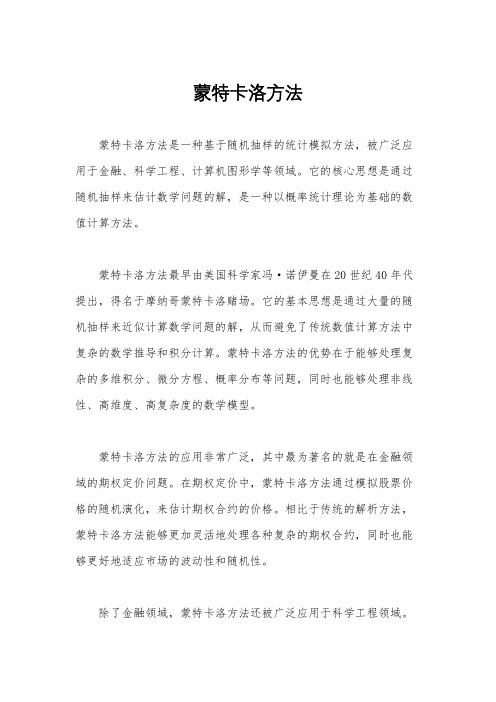
蒙特卡洛方法蒙特卡洛方法是一种基于随机抽样的统计模拟方法,被广泛应用于金融、科学工程、计算机图形学等领域。
它的核心思想是通过随机抽样来估计数学问题的解,是一种以概率统计理论为基础的数值计算方法。
蒙特卡洛方法最早由美国科学家冯·诺伊曼在20世纪40年代提出,得名于摩纳哥蒙特卡洛赌场。
它的基本思想是通过大量的随机抽样来近似计算数学问题的解,从而避免了传统数值计算方法中复杂的数学推导和积分计算。
蒙特卡洛方法的优势在于能够处理复杂的多维积分、微分方程、概率分布等问题,同时也能够处理非线性、高维度、高复杂度的数学模型。
蒙特卡洛方法的应用非常广泛,其中最为著名的就是在金融领域的期权定价问题。
在期权定价中,蒙特卡洛方法通过模拟股票价格的随机演化,来估计期权合约的价格。
相比于传统的解析方法,蒙特卡洛方法能够更加灵活地处理各种复杂的期权合约,同时也能够更好地适应市场的波动性和随机性。
除了金融领域,蒙特卡洛方法还被广泛应用于科学工程领域。
在物理学中,蒙特卡洛方法被用来模拟粒子的运动轨迹、核反应、辐射传输等问题;在生物学中,蒙特卡洛方法被用来模拟分子的构象、蛋白质的折叠、生物分子的相互作用等问题;在工程学中,蒙特卡洛方法被用来进行可靠性分析、风险评估、系统优化等问题。
在计算机图形学领域,蒙特卡洛方法被广泛应用于光线追踪、全局光照、体积渲染等问题。
通过蒙特卡洛方法,可以模拟光线在场景中的传播和反射,从而实现逼真的图像渲染效果。
总的来说,蒙特卡洛方法是一种强大的数值计算方法,它通过随机抽样来近似计算数学问题的解,能够处理各种复杂的数学模型,被广泛应用于金融、科学工程、计算机图形学等领域。
随着计算机计算能力的不断提高,蒙特卡洛方法将会在更多领域发挥重要作用,成为解决复杂问题的重要工具之一。
蒙特卡罗方法常用蒙特卡罗程序介绍

拒绝采样可以处理复杂、非标准形式的分布,且实现简单。
缺点
拒绝采样需要选择一个合适的建议分布和接受率以获得较高的抽样效率,且在某些情况下可能难以找到 合适的建议分布或接受率导致抽样效率低下。
03
蒙特卡罗方法在数学领域 应用
数值积分与微分
利用随机数进行数值积分
通过生成在指定区间内均匀分布的随机数,计算函数在这些随机数处的取值,并求平均来近似计算定 积分。
利用蒙特卡罗方法模拟相变过程中的临界现象,如临界指数、普 适类等。
有序-无序相变研究
模拟有序-无序相变过程,研究相变机制、相图以及临界行为等。
拓扑相变研究
通过蒙特卡罗方法模拟拓扑相变过程,探索拓扑序、拓扑缺陷以 及拓扑保护等物理现象。
05
蒙特卡罗方法在金融领域 应用
风险评估与建模
信用风险评估
利用蒙特卡罗方法模拟信贷资产组合中违约事件的发 生,进而估计预期损失和非预期损失。
统计物理
用于研究复杂系统的统计 性质,如相变、临界现象 等。
应用领域与前景
• 量子力学:用于求解薛定谔方程,研究原子、分子等微观粒子的性质。 • 金融工程:用于评估金融衍生品的价值、风险管理等问题。 • 优化问题:用于求解复杂的优化问题,如组合优化、非线性规划等。 • 前景:随着计算机技术的不断发展和算法的改进,蒙特卡罗方法的应用前景将更加广阔。未来,该方法将在更
通过构建二叉树模型模拟标的资产价格的变动路径,并利用蒙特卡罗方法进行期权定价的验证。
蒙特卡罗模拟定价
直接运用蒙特卡罗方法模拟期权到期日的收益,从而得到期权的预期收益和价格。
投资组合优化问题求解
1 2 3
有效前沿求解
利用蒙特卡罗方法模拟不同投资组合的收益和风 险,进而求解出一定风险水平下的最优投资组合。
蒙特卡罗方法的原理介绍

蒙特卡罗方法的原理介绍蒙特卡罗方法是一种基于随机抽样的数值计算方法,广泛应用于各个领域,如物理学、金融学、计算机科学等。
它的原理是通过随机抽样来模拟实验,从而得到近似的结果。
本文将介绍蒙特卡罗方法的原理及其应用。
一、蒙特卡罗方法的原理蒙特卡罗方法的原理可以简单概括为以下几个步骤:1. 定义问题:首先需要明确要解决的问题是什么,例如计算某个函数的积分、求解某个方程的解等。
2. 建立模型:根据问题的特点,建立相应的数学模型。
模型可以是一个函数、一个方程或者一个概率分布等。
3. 随机抽样:通过随机抽样的方法,生成符合模型要求的随机数。
这些随机数可以是服从某个特定分布的随机数,也可以是均匀分布的随机数。
4. 计算结果:利用生成的随机数,根据模型进行计算,得到近似的结果。
通常需要进行多次抽样和计算,以提高结果的准确性。
5. 分析结果:对得到的结果进行统计分析,计算均值、方差等统计量,评估结果的可靠性。
二、蒙特卡罗方法的应用蒙特卡罗方法在各个领域都有广泛的应用,下面以几个具体的例子来介绍。
1. 积分计算:蒙特卡罗方法可以用来计算复杂函数的积分。
通过在函数的定义域内进行随机抽样,计算抽样点的函数值的平均值,再乘以定义域的面积,即可得到函数的积分近似值。
2. 随机模拟:蒙特卡罗方法可以用来模拟随机事件的概率分布。
例如,在金融学中,可以使用蒙特卡罗方法来模拟股票价格的变动,从而评估投资组合的风险。
3. 数值求解:蒙特卡罗方法可以用来求解复杂方程的解。
通过在方程的定义域内进行随机抽样,计算抽样点的函数值,找到满足方程的解的概率分布。
4. 优化问题:蒙特卡罗方法可以用来求解优化问题。
通过在优化问题的定义域内进行随机抽样,计算抽样点的函数值,找到使函数取得最大或最小值的概率分布。
三、蒙特卡罗方法的优缺点蒙特卡罗方法具有以下优点:1. 适用范围广:蒙特卡罗方法可以应用于各种类型的问题,无论是求解数学问题还是模拟实际系统。
蒙特卡罗方法
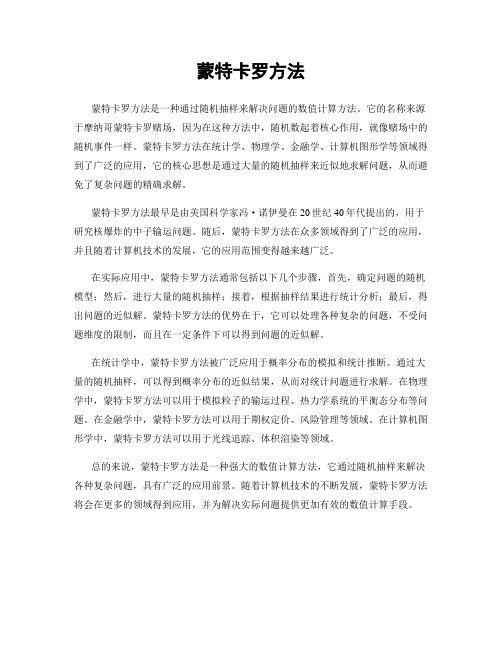
蒙特卡罗方法
蒙特卡罗方法是一种通过随机抽样来解决问题的数值计算方法。
它的名称来源于摩纳哥蒙特卡罗赌场,因为在这种方法中,随机数起着核心作用,就像赌场中的随机事件一样。
蒙特卡罗方法在统计学、物理学、金融学、计算机图形学等领域得到了广泛的应用,它的核心思想是通过大量的随机抽样来近似地求解问题,从而避免了复杂问题的精确求解。
蒙特卡罗方法最早是由美国科学家冯·诺伊曼在20世纪40年代提出的,用于研究核爆炸的中子输运问题。
随后,蒙特卡罗方法在众多领域得到了广泛的应用,并且随着计算机技术的发展,它的应用范围变得越来越广泛。
在实际应用中,蒙特卡罗方法通常包括以下几个步骤,首先,确定问题的随机模型;然后,进行大量的随机抽样;接着,根据抽样结果进行统计分析;最后,得出问题的近似解。
蒙特卡罗方法的优势在于,它可以处理各种复杂的问题,不受问题维度的限制,而且在一定条件下可以得到问题的近似解。
在统计学中,蒙特卡罗方法被广泛应用于概率分布的模拟和统计推断。
通过大量的随机抽样,可以得到概率分布的近似结果,从而对统计问题进行求解。
在物理学中,蒙特卡罗方法可以用于模拟粒子的输运过程、热力学系统的平衡态分布等问题。
在金融学中,蒙特卡罗方法可以用于期权定价、风险管理等领域。
在计算机图形学中,蒙特卡罗方法可以用于光线追踪、体积渲染等领域。
总的来说,蒙特卡罗方法是一种强大的数值计算方法,它通过随机抽样来解决各种复杂问题,具有广泛的应用前景。
随着计算机技术的不断发展,蒙特卡罗方法将会在更多的领域得到应用,并为解决实际问题提供更加有效的数值计算手段。
蒙特卡罗方法及其应用

蒙特卡罗方法及其应用蒙特卡罗方法是20世纪40年代提出的一种统计模拟方法,以蒙特卡罗赌城命名,因为那里以随机性闻名。
蒙特卡罗方法通过生成大量的随机样本,以此来解决问题。
它在数学、物理、工程、金融、计算机科学等领域有广泛的应用。
本文将介绍蒙特卡罗方法的基本原理、常见应用及优缺点。
1.定义问题的概率模型:将问题转化为概率模型,并定义相应的概率分布。
2.生成随机样本:利用随机数生成器生成符合概率分布的随机样本。
3.计算样本的函数值:将随机样本代入待求的函数,计算其函数值。
4.结果统计分析:利用大量的随机样本进行统计分析,得到问题的数值近似解。
1.数值积分:蒙特卡罗方法可以用来计算复杂的多维积分。
通过生成随机的样本点,并计算函数值,然后求取其均值,即可得到近似的积分值。
2.概率统计:蒙特卡罗方法可以用来估计随机事件的概率。
例如,可以通过生成大量的随机样本,计算事件发生的次数与总样本数的比值,得到近似概率估计。
3. 金融风险评估:蒙特卡罗方法可以用来评估金融产品的风险。
通过模拟资产价格的随机波动,计算投资组合的价值分布,以及不同市场条件下的风险指标,如价值-at-risk(VaR)等。
4.优化问题:蒙特卡罗方法可以用来解决优化问题。
例如,通过生成随机的样本点,并计算目标函数值,然后根据样本的统计信息,寻找最优解。
5.物理模拟:蒙特卡罗方法可以用来模拟物理过程,如粒子传输、能量传递等。
通过生成大量的随机样本,模拟微观过程的随机行为,可以得到宏观行为的统计结果。
1.灵活性:蒙特卡罗方法适用于各种复杂问题,无论问题的维度和复杂程度如何,都可以通过增加样本的数量来提高精度。
2.可并行计算:蒙特卡罗方法的运算过程可以并行计算,可以利用并行计算的优势提高计算效率。
3.建模简单:蒙特卡罗方法不需要对问题建立具体的数学模型,只需要定义问题的概率分布,较容易实现。
然而,蒙特卡罗方法也有一些缺点:1.计算效率低:蒙特卡罗方法通常需要生成大量的样本点,计算过程较为耗时,对于复杂问题可能需要很长的计算时间。
- 1、下载文档前请自行甄别文档内容的完整性,平台不提供额外的编辑、内容补充、找答案等附加服务。
- 2、"仅部分预览"的文档,不可在线预览部分如存在完整性等问题,可反馈申请退款(可完整预览的文档不适用该条件!)。
- 3、如文档侵犯您的权益,请联系客服反馈,我们会尽快为您处理(人工客服工作时间:9:00-18:30)。
(1915 - 1999)
More sophisticated algorithms: Different types of moves: (i) a particle is displaced, (ii) a particle is destroyed (no record kept), and (iii) a particle is created at a random position. Micorscopic reversibility by making the creation and destruction probabilities equal. Problems with high rejection rates (unfavorable overlaps when particle is created).
Grand Canonical Monte Carlo IV Movie
Kinetic Monte Carlo
Allows to simulate time evolution. However, not at the molecular level but by introducing reaction rates (which have to be known from elsewhere, e.g., from transition state theory). - At each step, system can jump from state A into one of the ending states Bi. survival probability: psurvival(t) = exp (-ktot t), ktot = ΣkABi integrated probability of escape between 0 and t: 1 – psurvival(t) - Repeated many times – Markovian process, i.e., system looses memory before doing the next step.
Random numbers chosen from a specific distribution (x) such that the function is evaluated in regions which make important contributions. Generating a Markov chain of states (functional values) f1, f2, f3, … which has a limiting distribution (x). In a Markov chain fn depends only on fn-1. fn linked to fn-1 by a transition probability pn-1,n
Advantages/Disadvantages of MC
+ Simple; no need to evaluate forces,
+ Directly samples the (canonical) statistical ensamble; no need to invoke the ergodic theorem,
Generates canonical ensemble with limiting distribution: exp(-(E-Nμ)/kT-lnN!-3NlnΛ+NlnV)!
Grand Canonical Monte Carlo II
Implementations Simple-minded method method: Randomly switching particles from ―existing― to ―ghost― by changing ocupancy numbers (1 or 0). Then applying Metropolis method (ghost atom moves always accepted).
Grand Canonical Monte Carlo III
Problems: In dense systems (fluids) it is hard to create a new particle without drastically increasing energy -> large rejection rate (special algorithms looking for cavites). Practical implementation – Widom insertion method: μ = -kT ln(QN/QN+1) μ = μideal gas + μexcess μexcess = -kT ln dsN+1 <exp(-(E(sN+1)-E(sN))/kT)>N - conventional NVT Monte Carlo with N particles, - frequent random insertions of an extra particle, - evaluation of exp(-(E(sN+1)-E(sN))/kT) & averaging
Most often used for surface diffusion or growth.
Kinetic Monte Carlo Procedure
A stochastic algorithm propagating the system A -> B -> C… - System is in state A, - For each path using known escape probability pABi we generate a random transition time tBi - We choose a path with shortest transition time tBmin - We proceed to the next step. Advantages: detailed balance preserved, long (second) times accessible. Problems: system can visit states which were not intuitively expected and for which rate constant is not given, small barriers question valididty of the Markov chain and shorten the accesible time scale.
1. Monte Carlo thods
Direct MC: hit & miss method Importance sampling: The Metropolis method Isobaric MC Grand canonical MC Kinetic MC
Direct MC
Normal integration methods (e.g., Simpson) impractical in many dimensions. Instead, Monte Carlo: Hit & miss method for estimating multidimensional integrals F = f(x) dx.
Isobaric Monte Carlo
NpT is the usual experimental ensemble: Additional factor in the partition function Zp = 0 dV VN exp (-pV/kT) Modified Metropolis method: From state with energy En-1 to state with energy En by randomly displacing particles and changing the volume (or lnV). Changing volume means displacing all particles & changing long range corrections (Ewald).
马尔可夫链理论和Monte Carlo 取样的实现
Microscopic reversibility:
fn pn,n-1 = fn-1 pn-1,n
A. A. Markov (1856 - 1922)
Metropolis method
From state with energy En-1 to state with energy En by randomly displacing a particle (or several particles, or all of them):
No inherent konwledge of f(x). Good when f(x) positively (or negatively) definite. Bad for oscillatory functions.
= 4 Nhit/Ntotal
Importance Sampling
Ideal acceptance ratio ~50%: too small – too high rejection rate, no move; too large - too small steps, little move.
